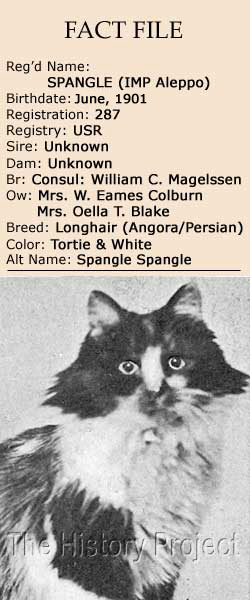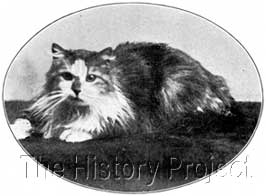 | |||||||||||||||||||









|
SPANGLE (1901)PHOTOS | SOCIAL MEDIA | REFERENCES
HISTORICAL BACKGROUND:Bi-colour and Parti-coloured longhairs have been part of the cat show scene from the very earliest of times, as is evidenced by those which were drawn by Harrison Weir himself, from exhibits entered in the very first Crystal Palace Show of July, 1871. Despite this, they did not prosper in England as they probably should have, as aside from Tabbies and Silvers (Chinchilla's) the majority of English breeders were focused almost solely on the facets of depth, purity and even-ness of colour, of clearing the coat of barring, and ensuring that the self-coloured cat was the best it could be. So a very great emphasis for a number of decades in fact, remained on the refinement of self-coloured cats and this moved also into the silvers, which suffered to large degree by variation of shading and barring, and few if any breeders, were seriously interested in the refinements associated with breeding a bi-colour and to ensure that by selection, they were correctly marked. As a result, no-one of consequence appears to have entertained the idea of retaining a bi-colour male for breeding.
Although styled upon the English system, the officers of the early American Cat Clubs, were more open to providing a separation of classes at shows, where multiple exhibits of a rarer colour might be entered. A classic example of this approach was that the American clubs were the first to separate the extremely popular White Longhairs into individual classes based upon eye colour. An Orange-eyed White would no longer compete directly with a Blue-eyed White or an Odd-eyed white, until they had gained a first in the class for their own eye colour, and so on. Likewise, the very pragmatic American fanciers opened up the classes for Bi-colours, so that Blacks with white competed firstly with other blacks with white and unlike in the English shows, where Black and Whites, Blue and Whites, Tabby and Whites etc. were invariably thrown together into one large A.O.C. (Any Other Colour) Class. Needless to say, the Bi-colour and Parti-coloured cat, received better publicity and were generally more popular in the United States than they were back in Britain. Among the earliest breeders to produce Bi-Colours was Mrs. Clinton Locke, whose well-marked 'Lockehaven Prince Colburn' was considered to be a standard-bearer for the correct markings. A number of early American breeders took up the challenge, with Mrs. W. Eames Colburn, Mrs. Oella T. Blake, and Miss Nella B. Wheatley, all from of Chicago, Mrs. E.N. Barker from New Jersey, Mr. Huidekoper and Miss Ava Pollard from New York, and Mrs. Charles Weed from Long Island, being among them.5
PARENTAGE & OWNERSHIP:
Unknown
Unknown
| Unknown
Spangle (IMP), Jun-1901, Tortie/White, F
| Unknown
Unknown
Unknown
It was Mrs. W. Eames Colburn of the 'Brushwood' Cattery, (well known for her Whites) and Mrs. Oella T. Blake of 'Spangle' Cattery that formed an alliance to import a Tortie and White Longhair. Mrs. Colburn was already in the processes of importing her famous black male 'BLACKTHORN' direct from Aleppo (in what is now modern day Northern Syria). Her contact in the region was the U.S. Consul, William C. Magelssen. There is every reason to believe that an opportunity arose to bring in a Tortie and White cat at the same time, and the cost would conceivably have been significant. But whatever the reason, Mrs. Colburn and Mrs. Blake jointly acquired 'Spangle' and she duly arrived in the United States, direct from the Middle East, very likely along with 'Black Thorn'. Of course, how she came about to be called 'Spangle' is a mystery, but suffice to say, that with Mrs. Blakes Cattery name also being Spangle, she ended up with the somewhat incongruous appellation of 'Spangle Spangle' and was just affectionately referred to by her singular 'proper' name. 'Black Thorn' (USR 100), was of course, from an unknown sire and dam, but being of excellent conformation and a direct import from Western Asia, he became one of the most sought after Black males in the United States and hence the sire of a string of well-known cats, among them, a superb male bred by Mrs. Colburn, named 'Menalowen Strongheart', born in 1904.3 'Spangle' (USR 287) was similarly from an unknown sire and dam, and we do not know what age she was when she was exported to the United States. However, she did breed successfully for Mrs. Blake, with her first American born litter very appropriately arriving on 4th July, 1902!1
SIBLINGS & SHOWS:Spangle was shown in 1903 at Chicago, where she won a 1st and a Special. BREEDING & PROGENY:We do not have an exact date of birth for 'Spangle' but a supposition has been made that in order for her to have been sourced, and of an age to travel safely and then be successfully bred and produce a litter in July of 1902, she is likely to have been at least in her second year of life by the time the litter this litter was born. This would put her own date of birth as circa 1901. Her date of birth in the Register of the Beresford Cat Club (BCC 637), is listed as June, 1901. 'Spangle' does appear to have been a regular and successful brood queen. For three consecutive years Mrs. Blake selectively bred her to three different, distinctly high-class males. The first breeding was to 'Black Thorn' which adds credence to the possibility that they may have travelled together from Aleppo. From this litter, born 4th July 1902, came a Black female with a white spot on her back. She was named 'Thorne Rose', and retained for breeding. 1
The following year, both 'Spangle' and her daughter 'Thorne Rose' were bred to 'Ravenswood Hamish', a lovely Orange male, who was acquiring quite a name for himself. 'Hamish' was owned by Mrs. F.W. Story, who also lived in Chicago, so neither female would have had to travel far to stud. 'Spangle' produced her litter first, on 10th July 1903, and from this litter came a Black male, who was named 'Black Douglas' (USR 162), who was similarly retained by Mrs. Blake.1 Her daughter kittened 20th August, 1903 and from this litter came a Black male, 'Nelusko',(USR 204), and two Bluecreams, one named 'Penelope', (USR 254) and one named 'Spangle Amaryllis' (USR 295). 'Amaryllis' was sold to Mrs. W.F. Godley, of Joliet, Illinois.1 In late 1903, 'Spangle' was bred to a prize-winning English imported Blue male named 'Lupin', owned by Mrs. Clinton Locke. Lupin was himself a son of the famous English Cream, 'Ch. Romaldkirk Midshipmite'. Her litter was born on 12th February, 1904 and it included a Red male, whom Mrs. Blake named 'Red Lotos' (USR 293). This male eventually followed 'Spangle's' grand-daughter "Amaryllis', to Mrs. W.F. Godley in Illinois.1 PHOTOS:
SOCIAL MEDIA :
'Spangle' was probably one of the prettiest imports to come from Western Asia, direct to the United States. But although she was carefully and selectively bred to the choicest solid males available, both from her own region and from the best of English and American lines, the lack of a quality Bi-Colour male to breed her to resulted in her producing mostly solid-coloured progeny. Nevertheless, her wonderful patching of Black, Red and White must have been a thrill to see, and would have shown her owners, that bright and cheerful colours were indeed achievable and something to attain to. REFERENCES:
Registers associated with this article include The Incorporated Cat Fanciers Association of Great Britain (TICFAGB), National Cat Club (NCC), The Cat Club (CCR), Beresford Cat Club (BCC), Feline Federation Francaise (FFF), Siamese Cat Registry (SCR), US Register & Studbook for Cats (USR)including Supplement(USRS), The Studbook of the American Cat Association (ACA), and the Studbook & Register of the Cat Fanciers' Association (CFA).
|
||||||||||||||||||
Home | Cats | Gallery | Clubs | People | Artifacts | Articles | Updates | Contact Us ©The CFA Foundation, Inc and The Harrison Weir Collection
|
|||||||||||||||||||







